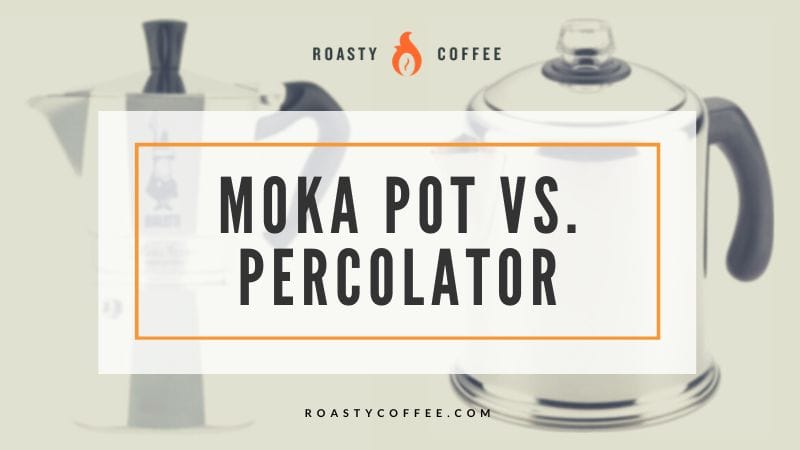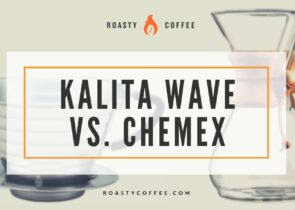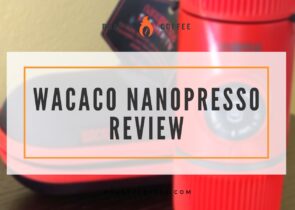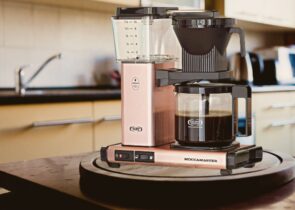Before there was home-brewed espresso, before the French press and drip were fashionable, before most people knew what Moka pot coffee was, and before coffee was so ubiquitous you could get it at a gas station, there were two choices for a cup of coffee; instant or percolator.
If you remember lava lamps, roll-down car windows, and leaded gasoline, you may also remember coffee percolators.
Along with the drip-coffee machine, this is America’s contribution to world coffee. It’s easy to make fun of percolator coffee as a relic of a bygone culture. But for generations, it has held a place for the coffee lover who likes their brewing method simple, enjoys making batches of coffee, and has no need for ‘fancy stuff’ like steamed milk or specialty coffee grounds.
Later the Moka pot came along, bringing a new era to coffee. It was the closest thing to home-brewed espresso coffee until the dedicated home kitchen espresso machines emerged.

Does a Percolator Make Espresso?
Though Moka pots and percolators used to be called ‘stovetop espresso makers,’ neither is, though Moka pot coffee comes much closer. Percolating coffee pots make almost the opposite of espresso with longer brew times, lower pressure that extracts few oils (therefore no crema), larger brew volumes, and coarsely ground milder roasts.
The only real thing percolator coffee has in common with espresso is strength. Espresso extracts robust flavor with pressure, and the percolator extracts it with multiple percolation cycles.
Moka pot coffee comes much closer by using a finer grind, darker beans, and pressure approaching an espresso machine to extract a small amount of crema. While still definitely not espresso, Moka pot flavors are richer and more earthy. If you need something stronger and richer and your choice is Moka pot vs Percolator, the Moka pot will give you coffee closer to your goals.
Is a Moka Pot the Same as a Percolator?
Moka pots and percolators look similar, but they use very different brewing processes and coffee and have distinctly different tastes. They both have a chamber for water and require a direct source of heat that moves heated water upwards with pressure, but that’s where the sameness ends.
While the Moka pot forces that pressure through the coffee puck to extract flavor, the percolator extracts more like a drip coffee maker, which drips hot water from above through the coffee to collect in the bottom of the pot.
Moka pot coffee is strong and rich, is extracted quickly from dark roasted beans, and has an earthy and bitter flavor. Percolator coffee, extracted for much longer and from a coarser grind, is thinner and more astringent, closer to drip than espresso.
The Moka Pot
Alfonso Bialetti is the father of the Moka pot and an icon of Italian design. He invented and perfected it at the height of the Art Deco period, and the basic design is unchanged today. The Moka Pot has been a kitchen standard in Italy and among Italians for decades because of its strong and broad flavor. It has made a resurgence as method-specific roasts and blends have become popular.
The Percolator
Joseph-Henry-Marie Laurens, a Parisian tinsmith, invented the percolator pot. But, it was Hanson Goodrich who perfected the modern coffee percolator 70 years later and gave it its American reputation, bringing decent coffee to middle America far from the coffee shops of the big cities.
These coffee makers became synonymous with cowboy films and the family camping trip, their vintage appeal and volumes of coffee having little of the aficionado quality some coffee has today.
As the method doesn’t require the finesse of the Moka pot, electric percolators have made percolator coffee common in places where volume and ease of use are important. They were once common in group kitchens, where they were easy to maintain. They are less common now that automatic drip machines are so popular, and automatic espresso is gaining market share.
How Are They Different?
Moka pots and percolators work on different principles. Both can make delicious coffee but should be understood for what they are so the right beans, grind, and taste can be chosen.
Moka pots make concentrated coffee by pushing hot water from the lower chamber under pressure upward through a filter basket to be expressed into the upper chamber. The force used is quite high though nowhere near espresso, but close enough to make rich and very strong espresso-like coffee.
Percolators don’t use as much pressure as Moka pots because they don’t push through the ground coffee. Instead, they push water up from the water chamber to stream out the top and flow down through the coffee basket, back into the bottom.
Another major difference is that the Moka pot uses pressure to make concentrated coffee in one brew cycle. The percolator’s brewing process circulates the coffee through a single chamber multiple times depending on how long you boil it, allowing you to choose the depth of flavor you want.
The brewing temperature is an additional difference. Moka pots and espresso machines extract the coffee below the boiling point. Percolators need boiling water to circulate the coffee through the grind, getting stronger and stronger as it goes. This can make the coffee bitter, something a Moka pot tends to avoid with its shorter extraction time.
Percolator coffee uses medium-ground coffee slightly coarser than that used with drip coffee makers. This grind is dumped into the filter basket and smoothed off, though when it was more popular prepackaged coffee ’rounds’ were common. A blade grinder for the coarse grind of percolator coffee as the larger particles required cannot be produced by some burr grinders that only grind as coarse as drip.
Percolators produce batches, usually several full cups of coffee, whereas a Moka pot makes shots, or at most a single cup. The Moka pot extracts in about a minute, whereas the stovetop percolator brews 5-7 minutes, or even longer for the larger pots often seen in group settings like boardrooms and conventions.
Percolators work much better on electric stoves; appliances the Moka pot doesn’t like as they take too long to heat. Percolators will happily sit on low heat for hours, constantly brewing to be ready when you want a cup, something impossible for a Moka pot that is only for immediate use.
How Are They Similar?
Moka pots and percolators need a heat source, have a lower and upper chamber, and make straight black coffee to which milk may be added later.
Percolators and Moka pots are made of stainless steel and polished aluminum and are utilitarian, able to stand up to the rigors of home use over the years. Both have a similar design profile with a heat-resistant handle, simple internal mechanism, and conductive base made for home stoves.
Both use a coarser grind than espresso, though Moka pot coffee is only slightly coarser, while the percolator uses a very coarse grind, even more, coarse than drip coffee makers.
Both make strong coffee by the cup and are tolerant of bean quality, letting you get a lot for your money in a day-to-day sense. They are brew methods for solid homemade stuff where you want Joe-to-go rather than the connoisseur experience. They are excellent for dinner parties, barbeques, and when everybody needs coffee.
Who Should Get A Moka Pot?
Moka pot coffee is seeing a resurgence, and for a good reason–now that people have started to really work them out, they’re finding a unique, rich coffee with an excellent taste profile made easily at home.
The Moka pot is an ideal way of brewing coffee for coffee drinkers dedicated enough to move on from drip-coffee makers toward better-tasting coffee with more depth of flavor from a more balanced brew.
Moka pot coffee doesn’t quite have the creamy flavor of authentic espresso as it’s not extracted under as much pressure. Still, it avoids uneven extraction with a single medium-length expression, making it perfect for medium-dark roasts and specialty blends.
Moka pots are ideal for the coffee connoisseur who wants to find the best in a bean and bring out a broad spectrum of flavors. They allow a lot of experimentation, especially the smaller pots, which are a great way to make short cups that let you try new beans in small quantities.
Who Should Get A Percolator?
A percolator is for you if you need strong coffee on hand constantly. It’s perfect for offices, school camps, conventions, the night shift in a firehouse, or maybe a missile silo.
Percolators don’t make sophisticated coffee, but they are very simple and robust and don’t need the attention a Moka pot does. Their simple brew cycle is perfect for a day when multiple cups are required. They are ideal for the home worker or a weekend at home when you are getting stuff done.
Percolators are popular with the RV and ‘digital nomad’ scene, being the smell soundtrack to many mornings in the camper park as they sputter and steam.
Percolators work best with bulk coffee, and, though the better the bean, the better the drink, if you’re working with large amounts like in an office or camp, they’re far more economical than using specialty beans for small shots of espresso.
Why Not Buy Both?
There was a time when this was not as much overkill as it sounds, and if you dig around some kitchens, it’s probably what you will find. For a time in the American home, the percolator was for everyday use, and the Moka pot came out to impress dinner guests or with Italian food.
These days of specialty coffee and better knowledge of roasts and grinds, owning both can work well with dedicated coffees. It’s now common to buy blends, roasts, and grinds on request, with many suppliers happily providing something that saves the percolator from its retro reputation.
Happy Caffeinating!









